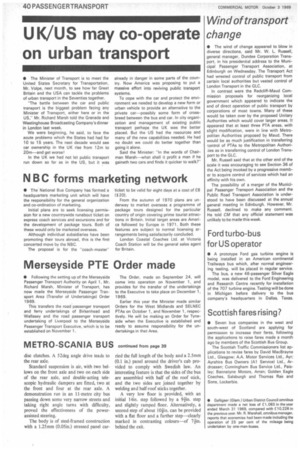Will Metro-Scania break through?
Page 45

Page 46

If you've noticed an error in this article please click here to report it so we can fix it.
by Derek Moses • British bus operators placing orders with Metro-Cammell Weymann Ltd. for the new Metro-Scania 11-metre integral singledeck bus (CM August 1) this month, could expect delivery during 1970. I was assured last week. This is at least one year ahead of the scheduled start of production of the new Leyland National integral singledecker (CM July 18).
I was told this during a visit to the SOdertilje chassis /engine construction and assembly plants of AB Scania Vabis. This was followed by a visit to the bus construction factory of Scania Bussar AB in Katrineholm, with a party of British busmen flown to Sweden to inspect the production of engine and transmission units and the assembly of the bodies which are involved in this interesting new Anglo-Swedish exercise.
Already two prototype buses are nearing completion in MCW's works, and will shortly be available for demonstration to UK operators. These buses were built by the Katrineholm plant, employing Scania Vabis engines and running units, and are based on the model CRI 10M city bus, suitably modified to meet the requirements laid down by the British Ministry of Transport for buses to qualify for the 25 per cent standard bus grants scheme. Later, however, MCW will build its own bodies.
The Swedish model illustrated here is an 11-metre integral bus with double-width entrance and separate double-width exit, seating 32 passengers with provision for 49 standing passengers. The major alteration affecting the Metro-Scania bus is that this 11-metre model will have a less curved frontal design with shorter overhang while retaining a double-width entrance. It will also have asymmetrical windscreens, with a deeper screen on the nearside for improved driver visibility, although it will retain the stylish rear contour.
In many ways the Metro-Scania will closely resemble the CR 110M structurally, and will have the same mechanical specification.
Specification
The basic specification of the Scania city bus, which will be followed on the MetroScania bus, is fully integral construction with separate front and rear axle subframes. A rear-mounted power pack is employed. in a similar concept to the Atlantean, Fleetline and Bristol VRT chassis, though with the engine mounted the opposite way. The engine is the Scania D II, a naturally-aspirated six-cylinder diesel engine with a maximum output of 202 bhp (DIN) at 2,200 rpm and it drives through a fullyautomatic gearbox with differential gear and
disc clutches. A 52deg angle drive leads to the rear axle.
Standard suspension is air, with two bellows on the front axle and two on each side of the rear axle, and double-acting telescopic hydraulic dampers are fitted, two at the front and four at the rear axle. A demonstration run in an 11-metre city bus passing down some very narrow streets and taking right angle turns with difficulty, proved the effectiveness of the powerassisted steering.
The body is of steel-framed construction with a 1.25mm (0.05in.) stressed panel car
ried the full length of the body and a 2.5mm (0.1 in.) panel around the driver's cab provided to comply with Swedish law. An interesting feature is that the sides of the bus are assembled with half of the roof stick, and the two sides are joined together by welding and half-roof sticks together.
A very low floor is provided, with an initial 14in. step followed by a nin. step and slightly ramped floor. Alternatively, a second step of about 104in. can be provided
with a flat floor and a further step clearly marked in contrasting colours—of 771-in. behind the exit.




































































































































